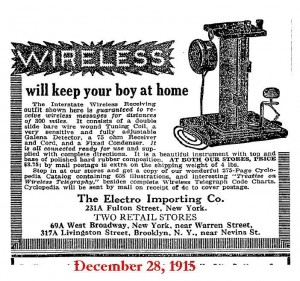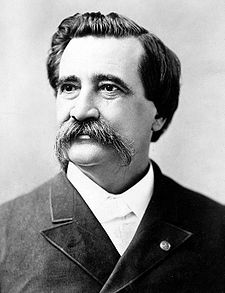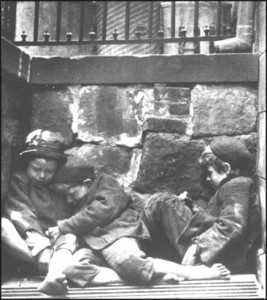The black turtleneck had yet to be invented. (Thanks Reddit.)
You are currently browsing the yearly archive for 2011.
Tags: Steve Jobs
Hugo Gernsback may have been America’s first professional futurist, and while he wasn’t always right he was always interesting. Gernsback invented the first home radio kits right after the turn of the nineteenth century and sold his gadgets by mail order from his Brooklyn offices. He loved science fiction as much as science–saw them as complements, really–and published some of the earliest examples of the form in his publications, including Amazing Stories. The sci-fi Hugo Award is named for him.
Gernsback never stopped trying to amaze with outlandish inventions and predictions. Just four years before his death, the July 26, 1963 issue of Life profiled the man in “Barnum of the Space Age,” which reported his prophecies for the future. An excerpt:
“Science is now so big, so flamboyant and so barnacled with politicians, press agents, generals and industrialists that Hugo Gernsback, who invented it back in 1908 (and has re-invented it, annually, since) can scarcely make himself heard above the babble of the late-comers. Although he is now 78, Gernsback is still a man of remarkable energy who raps out forecasts of future scientific wonders with the rapidity of a disintegrate gun. He believes that millions will eventually wear television eyeglasses–and has begun work on a model to speed the day. ‘Instant newspapers’ will be printed in U.S. homes by electromagnetic waves, in his opinion as soon as U.S. publishers wrench themselves out of the pit of stagnant thinking in which Gernsback feels they are wallowing at present. He also believes in the inevitability of teleportation–i.e., reproducing a ham sandwich at a distance by electronic means, much as images are now reproduced on a television screen.”
Tags: Hugo Gernsback
Here’s a classic 1992 homage to the mundane in which Andy Warhol chows down on Burger King. It’s a passage from Jørgen Leth’s 66 Scenes From America. The interminable post-meal period when Warhol prepares to speak was improvised by the Pop Artist.
Tags: Andy Warhol, Jørgen Leth
Sky News report about a South African family with a pet hippo.
Francis J. Alvany, the 19th-century bunco artist known as “Hungry Joe,” never had his fill when it came to schemes and dupes and ruses. Born in 1850, Hungry Joe spent most of his 52 years on Earth using hook, crook and any other means to separate marks from their money. He was so duplicitous that even when he passed away, no one was sure he wasn’t faking it. The New York Times dedicated newsprint to Hungry Joe’s chicanery as did the Brooklyn Daily Eagle. A trio of brief Eagle articles about his life and times follow.
••••••••••
“Hungry Joe and General John A. Logan” (May 5, 1889): “He came pretty near getting $150 out of General John A. Logan once. The general was in one of the rooms on the ground floor on the Twenty-third street side of the house where the ladies’ entrance is located. The boy at the door came and told me that the general had gone into his room accompanied by a bunco man. I went around and knocked at the door. Hungry Joe was just going away, but I barred the door and asked the general if he had given the fellow any money. The general was inclined to get nettled at my question, and blurted out that the young man was the son of the president of the bank in Chicago where the general’s account was kept. I said: ‘Why general, the man is a thief, a common thief.’ He would scarcely believe me. But presently Hungry Joe took $50 out of his pocket, which he got from Logan, and handing it back said I was on to him and the general might as well have his eyes opened. The general had given him $50 and was going to give him $100 the next day.”
••••••••••
“Hungry Joe Released” (Brooklyn Daily Eagle, June 21, 1896): “Hungry Joe, the famous bunco steerer and the man of many aliases, was released from the Maryland penitentiary this morning after serving a seven year’s sentence for swindling and left for New York at 8:10 A.M. He says he intends to become a bookmaker and follow the races for a living. Hungry Joe whose right name is said to be Alvany, is a native of Baltimore and is said to have swindled Oscar Wilde out of $1,500 during his checkered career. He was sent to the penitentiary here for swindling a Baltimore man out of $5,000, and has been a model prisoner, continually asserting his innocence of the crime of which he was convicted. He is said to be worth $150,000 as the result of his operations prior to his conviction.”
••••••••••

"With a simple three card monte game he emptied the pockets of a brother of a Brooklyn police captain." (Image by ZioDave.)
“Hungry Joe” (Brooklyn Daily Eagle, March 25, 1902): The late Hungry Joe–if he is late–was viewed with alarm by some and jealousy by others. The people who viewed him with alarm were those who were unfortunate enough to have money, or watches, or any other goods and chattels he wished to possess, for as he so wished he took them. The people who viewed him with jealousy, in which was a mixture of admiration, are the other people who try to get folks’ chattels away from them. For Joe was the slickest fellow in the bunco business. He it was who had the courage and the skill to wring money out of a judge of a criminal court, the late Judge Noah Davis. He bled the venerable Charles Francis Adam in Boston; he got hundreds of thousands of dollars from General Logan, Oscar Wilde and other more or less celebrities, and with a simple three card monte game he emptied the pockets of a brother of a Brooklyn police captain. The captain took it back.
Joe had partners who led his dupes into rooms where bogus gambling schemes were in operation, but for the boldest of his strikes he took no one into his confidence. In his way he was an artist, but his art was one that did not add much to the joy of nations, and in spite of his infrequent and mysterious exemption from arrest in this city he was arrested elsewhere and made to serve terms behind the bars. Probably he died–if he is dead–without leaving much to his heirs. Probably, also, if he had put the same ingenuity, the same address, the same energy into any decent business he would have made that business pay. This man elected–or elects–to pass his life in running away from the police. Either he buys safety with a large percent of his earnings, or he never knows sound sleep. He has his days of luxury and weeks of woe. It is a wretched, a contemptible life, that of a criminal, and nobody but a fool will choose it. Hungry Joe, the bunco king, was nobody’s fool at his work, but he was the poorest and cheapest of fools when he threw away the chance to make himself a rich, respected, useful man, to turn himself into a despised and hunted creature.”
Tags: Charles Francis Adam, Francis J. Alvany, General John A. Logan, Hungry Joe, Judge Noah Davis, Oscar Wilde
Nope, no idea.
Muckraking newspaperman Jacob Riis wasn’t any sort of radical socialist, just a very humane police reporter who knew how to use his abundant writing talent for forces of good. His 1890 book, How the Other Half Lives: Studies Among the Tenements of New York, was a landmark work of photojournalism that sought to expose the well-to-do classes of the city to the incredible hardships (child labor, sweatshops, unsanitary conditions, etc.) endured by the denizens of its poorest quarters, who were out of sight and out of mind.
The book succeeded tremendously in alerting the city to its Dickensian lack of social safety nets, but it continues to be a great read because it’s a genuine work of art, beautifully written and photographed. An excerpt from the chapter, “The Bend”:
“WHERE Mulberry Street crooks like an elbow within hail of the old depravity of the Five Points, is ‘the Bend,’ foul core of New York’s slums. Long years ago the cows coming home from the pasture trod a path over this hill. Echoes of tinkling bells linger there still, but they do not call up memories of green meadows and summer fields; they proclaim the home-coming of the ragpicker’s cart. In the memory of man the old cow-path has never been other than a vast human pig-sty. There is but one ‘Bend’ in the world, and it is enough. The city authorities, moved by the angry protests of ten years of sanitary reform effort, have decided that it is too much and must come down. Another Paradise Park will take its place and let in sunlight and air to work such transformation as at the Five Points, around the corner of the next block. Never was change more urgently needed. Around ‘the Bend’ cluster the bulk of the tenements that are stamped as altogether bad, even by the optimists of the Health Department. Incessant raids cannot keep down the crowds that make them their home. In the scores of back alleys, of stable lanes and hidden byways, of which the rent collector alone can keep track, they share such shelter as the ramshackle structures afford with every kind of abomination rifled from the dumps and ash-barrels of the city. Here, too, shunning the light, skulks the unclean beast of dishonest idleness. ‘The Bend’ is the home of the tramp as well as the rag-picker.”
Tags: Jacob Riis
An excerpt from “The Peekaboo Paradox,” Gene Weingarten’s excellent 2006 Washington Post chronicle of the complicated life of Eric Knaus, better known as D.C.’s most popular children’s party entertainer, the Great Zucchini:
“From the moment I met him, there were things that puzzled me about the Great Zucchini. Unless I drove him, for example, he relied on cabs to get to all of his gigs. He’d recently totaled his car, he explained, and hadn’t gotten around to buying a new one. Besides, he said, he found cabs less restrictive.
Also, the Great Zucchini didn’t seem to live anywhere. He had an address in Bethesda, but he would always want to meet at one Starbucks or another. Every time I proposed coming to his house some morning, he was staying elsewhere overnight. He seemed to crash everywhere but home.
His act was never fancy, but in recent months it had lost whatever frills it once had. On his Web site, the Great Zucchini is pictured at the White House Easter Egg Roll, where he once performed in a fancy black vest with cartoon smiley faces on it. He used to wear that vest to all his performances but lost it some time ago and has no plans to replace it.
He is more than a little disorganized. He lost a glowing-thumb trick, then found it, but it was broken, and he never got a new one. At one point, he lost his cell phone. When we were together, he often commandeered mine. Many of his magic props seem to be weathered to the point of decrepitude. His dirty diaper is years old. His magic bag with a false panel — a ‘change bag,’ in magicians’ terms — is soiled and ripped. The once-orange sponge balls he palms for an illusion are brown with use. And there’s that persistent, just-rolled-out-of-bed stubble. He didn’t always have that.
Some parents I talked to were worried that the Great Zucchini might be rotting on the vine. Their guess was substance abuse, or something even darker.
This was understandable, but wrong. His demons turned out to be of a different species, more benign, perhaps, but also more interesting.
Have you ever tried to peel a zucchini? It’s not like a potato. The skin is pretty thick. You don’t get it all with the first swipe.
Eric and I were in Arlington, at a fifth birthday party for a boy named Charlie. It was the first time the mother, Sarah Moore, had hired the Great Zucchini, and she had no complaints. He was everything she’d been told he’d be, she said, as she surveyed her post-party, preprandial dining room, aswarm with giddy kids.
‘He’s a big draw. You know, we wouldn’t have gotten half this turnout with a moon bounce,’ Sarah said, completely seriously.
On our way to the party, Eric and I had been talking football, and I had said I thought the New York Giants would win their next game. He agreed but said they wouldn’t beat the spread. I’d found that a little odd, and on our way back from the party I took a stab.
‘You’re a gambler,’ I said.
‘I need a cigarette,’ he said.
We stopped for cigarettes. He took a long drag, and smiled. It was as though he’d been waiting for this release for weeks.
‘Look, I’m not Mister Rogers, okay?'”
And carbon-based scone-ordering was suddenly threatened. (Thanks Geekosystem.)

"I am a 22 year old performance artist and experimental film maker with a pleasant disposition and positive outlook." (Image by Trampoline club du Dauphiné.)
Trampoline needed for film shoot!!! – $20 (Anywhere!)
This is maybe a strange request but I am looking to temporarily borrow and not buy a trampoline.
I am making a short film in which I desperately one!
My hopes are: You let me jump on your trampoline for no more than 30 mins and in return I bake you delicious treats or pay you the $20 I have suggested above!
I am a 22 year old performance artist and experimental film maker with a pleasant disposition and positive outlook.
Thank you in advance friends!
According to an article in The Week, there are 360,000 pieces of space junk (rocket debris, missle shards, old satellite hardware, etc.) orbiting Earth and threatening to destroy our current satellite systems. But Japan has a plan to use a metallic fish net to collect the floating flotsam. An excerpt:
“The Japanese Aerospace Exploration Agency has a solution. It has teamed up with Nitto Seimo, a fishing net manufacturer, to design a giant, metallic net to be launched into space. The net would rotate around the planet, and collect the orbital trash. Once the net is full, gravity would pull it toward Earth — and it would burn up as it re-entered the atmosphere. Japan wants to launch the net within the next two years.”
Gotta be uncomfortable for the monkey. And for everybody else.
Ralph Arlyck’s 15-minute 1970 film profiled his 4-year-old neighbor Sean Farrell, who lived in a Haight-Ashbury hippie household with his parents and whoever else drifted through. The short doc became quite the sensation because the tyke discussed his marijuana use. In 2005, there was a long-form follow-up doc called Following Sean.
Tags: Ralph Arlyck, Sean Farrell
Grover Lewis was a prominent New Journalism writer of the 1960s and 1970s, probably best known for his Rolling Stone on-location pieces in which he ensconced himself on film sets and gave readers a behind-the-scenes look at how Sam Peckinpah and John Huston, among others, got their work done. He also had a taste for the film business’s fascinating fringe characters.
Lewis passed away in 1995 while in the midst of writing his memoirs. Unlike many of his contemporaries, Lewis is all but forgotten, despite the existence of a handsome collection of his work, Splendor in the Short Grass, which was published by the University of Texas Press in 2005. The book contains a piece taken from his uncompleted memoirs, in which Lewis recalls the tragic circumstances of how he lost both his parents while he was eight years old. An excerpt from “Goodbye If You Call That Gone”:
“History and legend bind us to the past, along with unquenchable memory.
In the spring of 1943, my parents–Grover Lewis, a truck driver, and Opal Bailey Lewis, a hotel waitress–shot each other to death with a pawnshop pistol. For most of a year, Big Grover had stalked my mother, my four-year-old sister, and me across backwater Texas, resisting Opal’s decision to divorce him. When she finally did and when he finally cornered her and pulled the trigger as he’d promised to do, she seized the gun and killed him, too.
A next-door neighbor of Opal’s–called ‘Dad’ North because of his advanced age–witnessed the mayhem shortly after dawn on a rainy Monday morning in May. Big Grover was twenty-seven years old, Opal twenty-six, and they’d been married for almost eleven years. My father survived for half a day without regaining consciousness, and died in the same charity hospital where I was born. Opal died where she fell, under a shadeless light bulb in the drafty old rooming house where she’d been living alone, and struggling to keep Titter and me in a nearby nursery school. No charges were filed, and a formal inquest was considered unnecessary since the police and the coroner’s office declared the case solved by mid-morning. My uncle Dubya Cee, Opal’s older brother, talked to one of the detectives involved and found out some additional information, which he shared only with the Bailey elders. Such, anyway, were the bare bones of the story as passed along in family history that soon blurred off into murky family legend. It was the sum of what I was allowed to know, although there remained to be answered, of course, questions I had not yet learned to ask.”
Tags: Grover Lewis
Robert Krulwich has a story on NPR about meat-eating furniture, including the flypaper clock featured in this video. At least it doesn’t show the coffee table that guillotines and devours mice that it attracts with cheese bits. No joke.
Tags: Robert Krulwich
Juxtapoz has a photo series about the work of Dutch artist Ron van der Ende, who uses found wood to carve hyperrealistic sculptures of artifacts of the Industrial and Information Ages. In an interview with diskursdisco, the artist explains how he creates his work:
“Ron van der Ende: I collect old doors and stuff. Old painted wood that I find in the street. I take it apart and skin it to obtain a 3mm thick veneer with the old paint layers still intact. I construct bas-reliefs that I cover with these veneers much like a constructed mosaic. I do not paint them!”
Tags: Ron van der Ende
Ragged urchins were everywhere in Brooklyn in the 1890s. One such lad, named Jon Wright, had an adventure that involved a hatchet, a slot machine and some chocolate. The Daily Eagle reported on his thievery in its August 5, 1891 issue. An excerpt:
“Jon Wright is a ragged urchin 12 years old and living at 39 Bergen street. He was arrested this morning by Officer James W. Webb at 4 o’clock while parading West Brighton armed with a hatchet.
When the officer asked him what he was doing out at that hour he explained that he was ‘hustling.’
‘You’ll hustle to police headquarters,’ said the officer.
On the way the officer noticed the boy’s pockets bulging out, and on searching found in them a couple of quarts of chocolates, such as come out of the nickel slot machines. The boy said he had broken open some machines with the ax because he liked chocolate. Beside, he had not been home for some days and was hungry. He was a cool little fellow and asked for a cigarette as soon as he got in the cell. He was held until his story should be verified.”
Tags: Jon Wright, Officer James W. Webb
China simply doesn’t have this type of ingenuity. (Thanks Reddit.)

You can't tell from the gates of Hollybrook Cemetery in Southampton, but it's like a Disney cartoon inside. Click the "Daily Mail" article to see some examples.
Emily Dickinson’s words about religious worship (“Some keep the Sabbath going to the Church —
/ I keep it, staying at Home”) should apply equally to mourning. For some people it’s a private occasion and for others it’s a New Orleans funeral. No one should tell someone else how to mourn.
Marginal Revolution pointed me to an article by Bel Mooney in the Daily Mail about colorful graveyards in England, which are overflowing with bright balloons, toys and sculptures of cartoon characters. Some people are not happy about it. An excerpt:
“There is a growing trend for graves to be festooned with toys, plastic ornaments and trinkets, balloons, wind-chimes and hanging objects.
The sight and sound of these exhibitions grows ever more exuberant – so much so that an Essex council is introducing a one-month limit on what can be put on a grave. Other councils are surely likely to follow.
Traditionalists argue that graveyards are places of peace and contemplation and those who visit to lay flowers on Mum’s grave shouldn’t have to negotiate their way past piles of soft toys or be disturbed by the cacophony of competing wind-chimes.
But for their part, those who want to heap graves with cuddly toys protest their right to remember their dead in whatever way they choose. Which means that anything goes, from a gravestone in the shape of a Newcastle United shirt, to life-sized effigies of the deceased, to resin pigs and dogs, plastic dolphins and even meerkats.
I would never use the word ‘tacky’ to describe such displays – though many people do. It sounds too snobbish, too much to do with a certain kind of taste.”
Tags: Bel Mooney
“God’s Angry Man,” Werner Herzog’s 1980 look at Los Angeles televangelist Gene Scott, follows the colorful Stanford grad who screamed at and threatened his television flock with pro-wrestling flair. Herzog’s portrait captures the holy man at the height of his powers. What became of Scott in the years after the film? He divorced and remarried in his dotage, becoming wedded to a pretty 32-year-old woman named Melissa, who was previously known as porn star “Barbie Bridges.” Scott, who died in 2005, was remembered in a Los Angeles Times obituary. An excerpt:
Gene Scott, the shaggy, cigar-smoking televangelist whose eccentric religious broadcasts were beamed around the world, has died. He was 75.
Scott died Monday after a stroke, family spokesman Robert Emmers said.
For three decades, Scott was pastor of Los Angeles University Cathedral, a Protestant congregation of more than 15,000 members housed in a landmark downtown building.
In the mid-1970s, Scott began hosting a nightly live television broadcast of Bible teaching. His nightly talk show and Sunday morning church services were aired on radio and television stations to about 180 countries around the world by his University Network.
Scott was most recognizable by his mane of white hair and scruffy beard.•
Tags: Gene Scott, Melissa Scott, Werner Herzog
AUTOSKREELIK (SOZO)
Private collector seeking: Prosthetics, lusus naturae, medical devices, anatomical bits, mech, 3-D, tools, analog communication, taxidermy, interesting things in jars, conjoined_____?, head(s) on stick(s), dolls no one will look at, foetus, scientific ephemera, parasites, curious moulds, masks, skin, iron maiden, photographs, skellingtons, exotic ducks, eyes, flail. I am not in retail. Pictures appreciated.
Bill Bowerman, Arnold Schwarzenegger and the recently deceased Jack LaLanne all helped spark fitness crazes in America, but half-crazy Arkansan Arthur Jones may have had a bigger influence on the modern health club than anyone else. Jones created Nautilus machines, which resembled the exterior of a shellfish, selling his first unit in 1970. This equipment shifted the focus of exercise from barbell lifting to high-intensity machine training.
In 1985, Time profiled Jones and his growing empire. If he just pioneered exercise equipment, Jones would have been interesting in a small way. But he was also a cantankerous world traveler and adventurer who was married six times to much younger women and had the kind of massive ego and appetites particular to the self-made American male.
His 2007 obituary in the New York Times included Jones’ famous quote: “I shot 630 elephants and 63 men, and I regret the elephants more.” An excerpt from the Time piece about Jones when he was 58:
“The gravel-voiced Jones has none of the polish of his machines. He wears horn-rimmed glasses and ill-fitting pants, gulps coffee, chain-smokes Pall Malls and often totes a Colt .45. ‘When I was broke, I was crazy; now that I am rich, I am eccentric,’ he declares. He is about 65 but refuses to confirm it. His motto for summing up his favorite pursuits: ‘Younger women, faster airplanes and bigger crocodiles.’
Jones has had five wives, all of whom he married when they were between the ages of 16 and 20. He lives with his current spouse Terri, 23, on his 600-acre Jumbo Lair spread near Ocala, Fla., which is also home to 90 elephants, three rhinos, a gorilla, 150 snakes, 300 alligators and 400 crocodiles. The animals come in handy for Jones’ research projects, which he and his staff conduct with no particular goal. ‘If I knew what I was going to discover, I wouldn’t do it,’ huffs Jones. ‘Very little in life happens according to plan.’ But with his growing fortune, Jones has plans that tend to happen.”
Tags: Arthur Jones
The acquisition of the Huffington Post gives AOL ownership of some brilliant muckraking.
Tags: Arianna Huffington, Jenny McCarthy




















